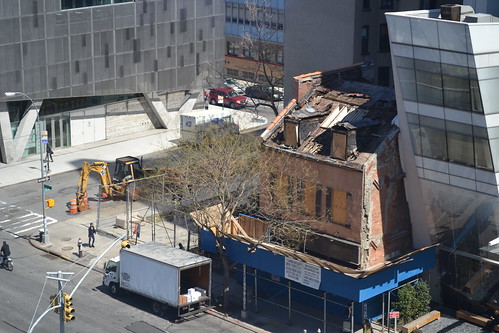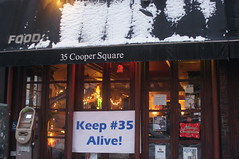 Ian Duncan The author, one of the preservationists trying to forestall the demolition of 35 Cooper Square, issues a call to the developer of the site to cover the roof to prevent further damage. Below: A detail of the roof shortly after work began in February.
Ian Duncan The author, one of the preservationists trying to forestall the demolition of 35 Cooper Square, issues a call to the developer of the site to cover the roof to prevent further damage. Below: A detail of the roof shortly after work began in February.The recent article, “Developer Cited for 35 Cooper’s Roof” had some readers curious re what’s so important about the roof. The history of this building has been well-told, but the roof and dormers as essential structural elements and character-defining features, are currently compromised by partial demolition and exposure to the elements. Any effort to save this building, at this point, needs to start with the basics: putting a tarp back on the roof.
Over the winter, roofing material was removed by workers hired by the new owner under a permit for asbestos abatement, a prerequisite for obtaining a demolition permit. The dormers were similarly stripped of their protective roofing, and non-historic skylights were removed, exposing not only the roof structure but the upper floors of the building to the elements. The old wooden shingles, part of the historic fabric of the building, are now visible, but so too are the gaping holes in the roof. The rain and snow of the past few months are surely accelerating any decay and rot in the 185-year-old structure smacks of demolition by willful neglect.
As a Federal-style structure, its peaked gambrel roof and twin dormer windows are its most distinctive and character-defining elements. The developer’s failure to cover the roof seems to be more than just benign neglect, just as the damage done to the building’s dormers was not accidental. Eliminating distinctive architectural elements to pre-empt calls for preservation has become common practice in this community. Last year, for example, the distinctive oval windows and mansard roof of the first Germania Bank Building (185 Bowery) were destroyed to eliminate objections to a rumored four-lot-wide, thirty-story luxury hotel plan.
As was explained at our recent meeting with the developer, covering the roof would not be an expensive undertaking, since a protective tarp already exists for the building. Leaving the roof exposed to the elements rapidly degrades its remaining historic fabric, thus making it far more expensive to restore, and therefore creating a self-fulfilling argument against the broad calls for preservation.
As Pete Hamill stated at the candlelight vigil for 35 Cooper Square, “In order to make the present as rich as possible, you have to have a sense of the past. . .This is our inheritance.” Some developers understand this, and have been able to make even small historic spaces yield gold. As the restaurateur Keith McNally has written, “Development in any neighborhood may be inevitable, but in as noted and distinctive an area as the Bowery it is desirable only as long as it preserves the neighborhood’s character while enhancing its value.”
We are hopeful that developer Arun Bhatia will recognize the importance and economic potential of 35 Cooper Square. Preserving it would be a wonderful gift to the neighborhood and would bestow tremendous honor and prestige on him. While the community anxiously awaits to hear whether Mr. Bhatia will incorporate a preserved 35 Cooper Square into his 35-39 Cooper Square development plan, we do wish he would put the protective covering back on the building.
David Mulkins is a co-founder of the Bowery Alliance of Neighbors.





